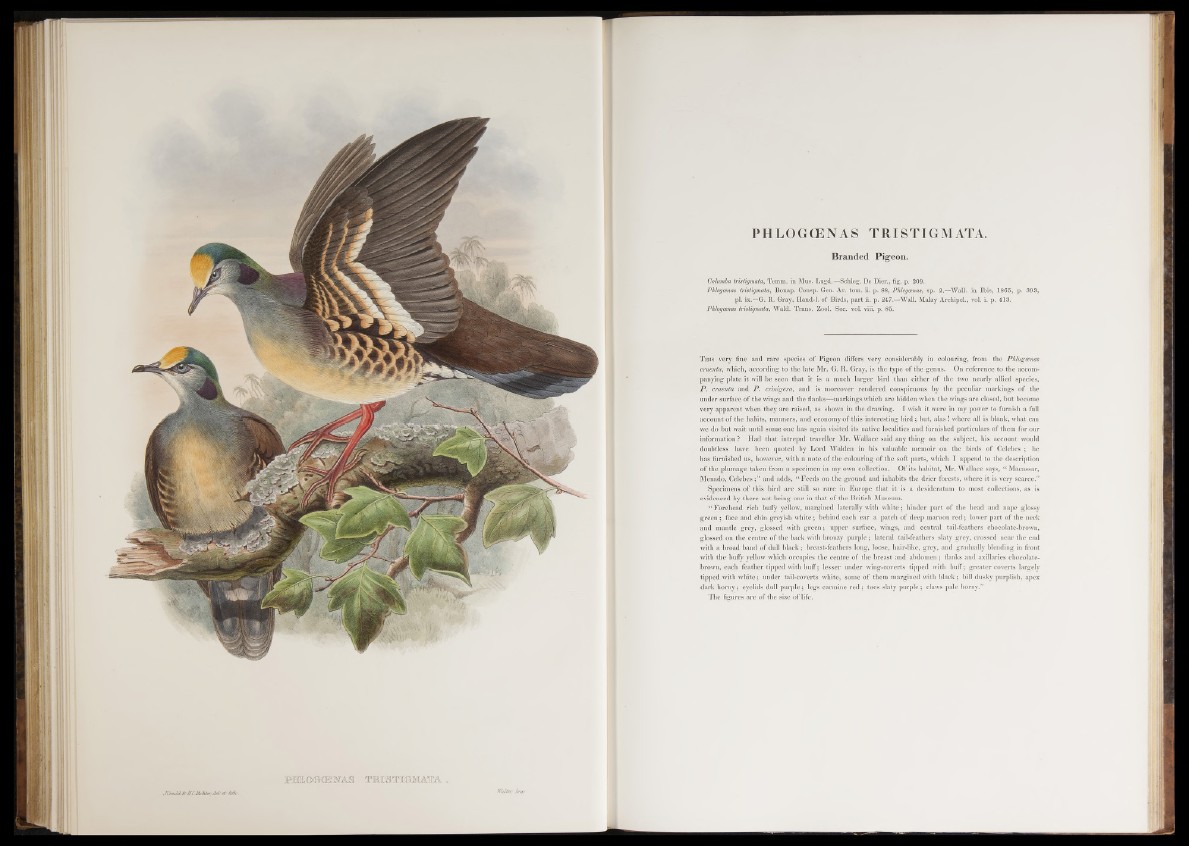
PUL© (ME JSAS TRIS TIGMATA. .
JGouMfrECMhUr, dd/et% M i/. Walter, Jmp.
PHLOGCENAS TRISTIGMATA.
Branded Pigeon.
Col-umba tristigmata, Temm. in Mus. Lugd.—Schleg. De Bier., fig. p. 209.
Pklegcenas tristigmata, Bonap. Consp. Gen. Av. tom. ii. p. 88, Phlegcenas, sp. 2.—Wall, in Ibis, 1865, p. 393,
pi. ix .—G. R. Gray, Hand-1, of Birds, part ii. p. 247.—Wall. Malay Archipel., vol. i. p. 413.
Phlogcenas tristigmata, Wald. Trans. Zool. Soc. vol. viii. p. 85.
T h i s very fine and rare species of Pigeon differs very considerably in colouring, from the Phlogcenas
cruenta, which, according to the late Mr. G. R. Gray, is the type of the genus. On reference to the accompanying
plate it will be seen that it is a much larger bird than either o f the two nearly allied species,
P . cruenta and P . crinigera, and is moreover rendered conspicuous by the peculiar markings of the
under surface o f the wings and the flanks—markings which are hidden when the wings are closed, but become
very apparent when they are raised, as shown in the drawing. I wish it were in my power to furnish a full
account o f the habits, manners, and economy o f this interesting bird; but, alas! where all is blank, what can
we do but wait until some one has again visited its native localities and furnished particulars of them for our
information ? Had that intrepid traveller Mr. Wallace said any thing on the subject, his account would
doubtless have been quoted by Lord Walden in his valuable memoir on the birds o f Celebes ; he
has furnished us, however, with a note of the colouring of the soft parts, which I append to the description
of the plumage taken from a specimen in my own collection. Of its habitat, Mr. Wallace says, “ Macassar,
Menado, C e le b e s a n d adds, “ Feeds on the ground and inhabits the drier forests, where it is very scarce.”
Specimens of this bird are still so rare in Europe that it is a desideratum to most collections, as is
evidenced by there not being one in that of the British Museum.
“ Forehead rich buffy yellow, margined laterally with white; hinder part of the head and nape glossy
green; face and chin greyish white; behind each ear a patch of deep maroon red; lower part of the neck
and mantle grey, glossed with green; upper surface, wings, and central tail-feathers chocolate-brown,
glossed on the centre of the back with bronzy purple; lateral tail-feathers slaty grey, crossed near the end
with a broad band of dull black; breast-feathers long, loose, hair-like, grey, and gradually blending in front
with the buffy yellow whicb occupies the centre of the breast and abdomen; flanks and axillaries chocolate-
brown, each feather tipped with buff; lesser under wing-coverts tipped with buff; greater coverts largely
tipped with white; under tail-coverts white, some of them margined with black; bill dusky purplish, apex
dark horny; eyelids dull purple; legs carmine red; toes slaty purple; claws pale horny.”
The figures are of the size of life.